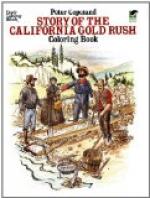But James W. Marshall was the man who started the great excitement of ’48 and ’49 by finding small pieces of gold at a place now called Coloma, on the American River. Marshall, who was born in New Jersey, came to this state in 1847, and being a builder wished to put up houses, sawmills, and flour-mills. Finding that lumber was very dear, he decided to build a sawmill to exit up the great trees on the river-bank. He had no money, but John A. Sutter, knowing a mill was needed there, gave Marshall enough to start with.
So the mill was built, and when it was ready to run Marshall found that the mill-race, or ditch for carrying the water to his mill-wheel, was not deep enough. He turned a strong current of water into it, and this ran all night. Then it was shut off, and next day the ditch showed where the stream had washed it deeper and had left a heap of sand and gravel at the end of it. Here Marshall saw some shining little stones, and picking them up he laid one on a rock and hammered it with another till he saw how quickly it changed its shape. He was sure that these bright, heavy, easily hammered pebbles were gold, but the men working about the mill would not believe it. So he went to Sutter, who lived near at a place called Sutter’s Fort, because his stores, house, and other buildings were built around a hollow square with high walls outside to keep off the Indians. Sutter weighed the little yellow lumps and said they certainly were gold.
The flood-gates between the mill-race and the river were opened again, and water ran through the ditch, washing more gold in sight. Sutter picked up enough of this to make a ring and had these words marked on it:—
“The first gold found in California, January, 1848.”
Both Sutter and Marshall tried to keep what they had found a secret, but that was impossible, and soon people were flocking to the gold-fields. Then began a wild excitement known as the “gold-fever,” and men left their stores and houses, gave up business, and left crops ungathered in a wild chase after nuggets of gold.
By December of 1848, thousands of miners were washing for gold all along the foot-hills from the Tuolumne River to the Feather, a distance of 150 miles. A hundred thousand men came to California during 1849, these Argonauts, or gold-hunters, taking ship or steamer for the long trip from New York by the Isthmus of Panama. Some went round Cape Horn, or else made a weary journey overland across the plains. “To the land of gold” was their motto, and these pioneers endured every hardship to reach this “Golden State.”
Then the miners, with pick, shovel, and pan for washing out gold from the gravel it was found in, started out “prospecting” for “pay-dirt.” The gold-diggings were usually along the rivers, and this surface, or “placer,” mining was done by shovelling the “pay-dirt” into a pan or a wooden box called a cradle, and rocking or shaking this box from side to side while pouring water over the earth. The heavy gold, either in fine scales or dust, or in lumps called nuggets, dropped to the bottom, while the loose earth ran out in a muddy stream. The rich sand left in pan or cradle was carefully washed again and again till only precious, shining gold remained.




